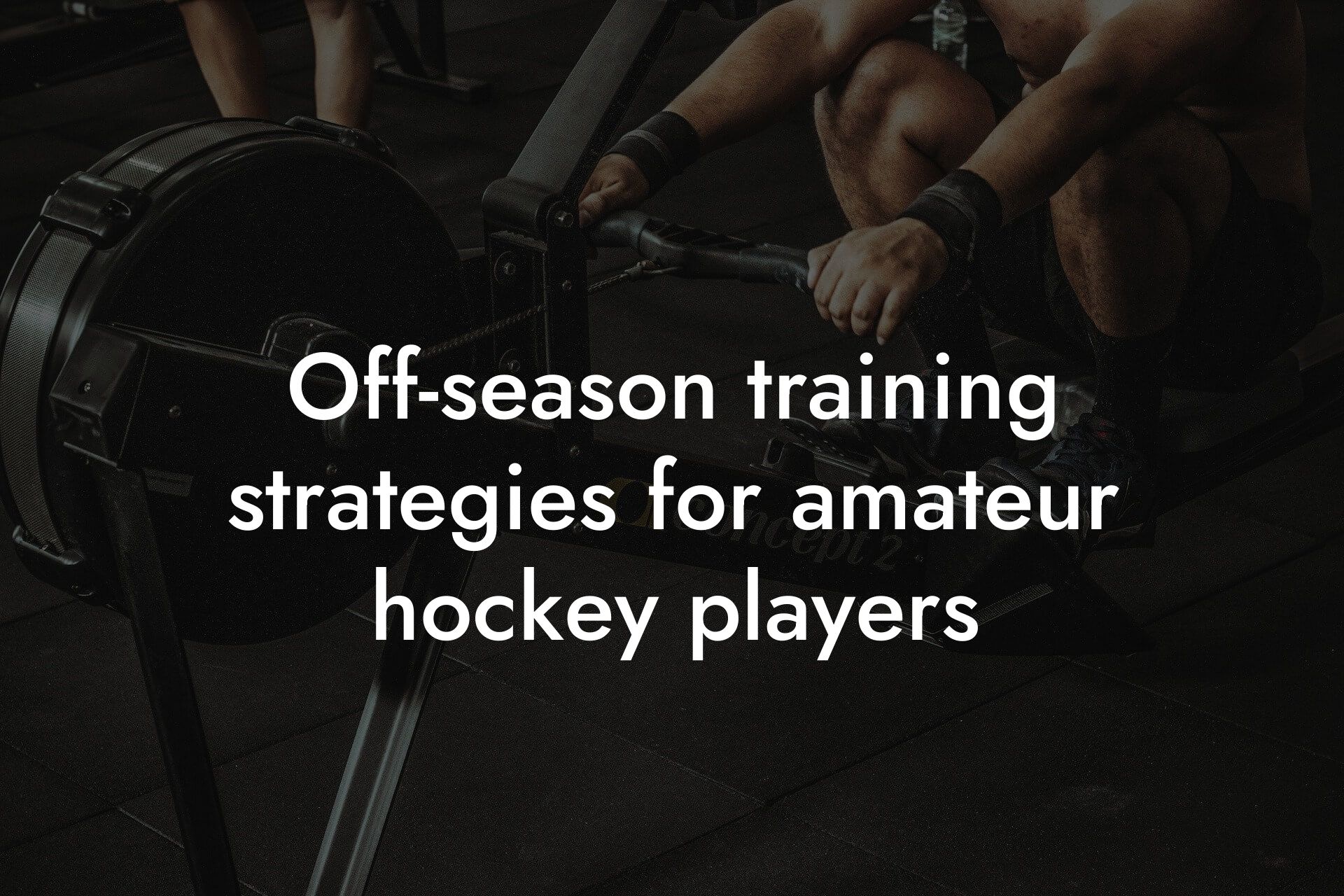As a high-earning professional, you understand the importance of maintaining a strong and healthy physique. Whether you're a recreational hockey player or a competitive athlete, having adequate muscle mass is crucial for optimal performance on the ice. In this article, we'll delve into the significance of muscle mass for strength on the ice and provide you with valuable insights to take your game to the next level.
Table of Contents
- What is Muscle Mass?
- Why is Muscle Mass Important for Strength on the Ice?
- The Relationship Between Muscle Mass and Power
- The Impact of Muscle Mass on Speed and Agility
- The Role of Muscle Mass in Injury Prevention
- How to Build and Maintain Muscle Mass for Hockey Performance
- How DEXA Scans Can Help You Optimize Your Muscle Mass for Hockey Performance
- Frequently Asked Questions
What is Muscle Mass?
Muscle mass refers to the amount of muscle tissue in your body. It's an important component of overall body composition, which also includes body fat, bone density, and water. Muscle mass is made up of skeletal muscle, which is responsible for movement, and smooth muscle, which is found in the walls of blood vessels and hollow organs. Having adequate muscle mass is essential for overall health, athletic performance, and everyday functioning.
Why is Muscle Mass Important for Strength on the Ice?
Muscle mass plays a critical role in generating strength, power, and speed on the ice. When you have adequate muscle mass, you're able to produce more force and accelerate faster, which is essential for quick changes of direction, explosive acceleration, and maintaining speed. Additionally, muscle mass helps to improve your overall stability and balance, reducing your risk of injury and improving your overall performance.
The Relationship Between Muscle Mass and Power
Power is the ability to generate force quickly, and it's a critical component of hockey performance. Research has shown that muscle mass is strongly correlated with power output. In other words, the more muscle mass you have, the more power you're able to generate. This is because muscle mass provides the necessary force production to accelerate and decelerate quickly, which is essential for hockey-specific movements like acceleration, deceleration, and changing direction.
The Impact of Muscle Mass on Speed and Agility
Speed and agility are critical components of hockey performance, and muscle mass plays a significant role in both. When you have adequate muscle mass, you're able to generate more force and accelerate faster, which allows you to cover more ground and change direction quickly. Additionally, muscle mass helps to improve your overall reaction time and responsiveness, allowing you to react faster to changing situations on the ice.
The Role of Muscle Mass in Injury Prevention
Injury prevention is a critical aspect of hockey performance, and muscle mass plays a significant role in reducing your risk of injury. When you have adequate muscle mass, you're better able to absorb and distribute the forces associated with hockey-specific movements, reducing your risk of injury. Additionally, muscle mass helps to improve your overall stability and balance, reducing your risk of falls and other injuries.
How to Build and Maintain Muscle Mass for Hockey Performance
Building and maintaining muscle mass requires a combination of proper nutrition, training, and recovery. Here are some tips to help you build and maintain muscle mass for hockey performance:
- Eat enough protein: Aim to consume 1.6-2.2 grams of protein per kilogram of body weight daily to support muscle growth and repair.
- Focus on strength training: Incorporate exercises like squats, deadlifts, and lunges into your training program to build strength and muscle mass.
- Incorporate plyometric exercises: Exercises like jump squats and box jumps can help improve your power output and muscle mass.
- Get enough rest and recovery: Adequate rest and recovery are critical for muscle growth and repair. Aim for 7-9 hours of sleep daily and take rest days as needed.
How DEXA Scans Can Help You Optimize Your Muscle Mass for Hockey Performance
DEXA (Dual-Energy X-ray Absorptiometry) scans are a valuable tool for assessing body composition, including muscle mass. By providing a detailed breakdown of your body composition, DEXA scans can help you identify areas for improvement and optimize your training and nutrition programs for optimal muscle mass and hockey performance. At Tano Performance Group, we use DEXA scans as part of our comprehensive body assessment program to help high-earning professionals like you achieve their physique and performance goals.
In conclusion, muscle mass is a critical component of strength on the ice. By understanding the importance of muscle mass and how to build and maintain it, you can optimize your hockey performance and reduce your risk of injury. Remember to focus on proper nutrition, training, and recovery, and consider incorporating DEXA scans into your training program to get a detailed breakdown of your body composition. With the right approach, you can take your hockey performance to the next level and achieve your goals.
Frequently Asked Questions
What is the primary role of muscle mass in ice hockey performance?
Muscle mass plays a crucial role in generating strength, power, and speed on the ice. Having adequate muscle mass enables hockey players to accelerate, decelerate, and change direction quickly, which is essential for success in the sport.
How does muscle mass impact a hockey player's acceleration?
Muscle mass is directly related to an individual's ability to generate force. The more muscle mass a player has, the more force they can produce, resulting in faster acceleration and deceleration on the ice.
What is the ideal muscle mass range for hockey players?
The ideal muscle mass range for hockey players varies depending on position and individual goals. Generally, forwards tend to have a higher percentage of lean muscle mass than defensemen, who require more strength and power. Aiming for a body fat percentage between 8-12% is a good starting point for most players.
How does muscle mass affect a player's endurance on the ice?
Having adequate muscle mass helps players maintain their speed and agility throughout the game. As muscle mass increases, so does a player's anaerobic endurance, allowing them to sustain high-intensity efforts over a longer period.
What are the consequences of inadequate muscle mass for hockey players?
Inadequate muscle mass can lead to decreased strength, power, and speed, making it challenging for players to compete at a high level. It can also increase the risk of injury, as players may be more prone to fatigue and poor technique.
How can hockey players increase their muscle mass?
Hockey players can increase their muscle mass through a combination of proper nutrition, resistance training, and sufficient rest and recovery. A diet rich in protein, complex carbohydrates, and healthy fats provides the necessary building blocks for muscle growth and repair.
What is the importance of protein in muscle mass development?
Protein is essential for muscle growth and repair. Aim to consume 1.6-2.2 grams of protein per kilogram of body weight daily, spread across 3-5 main meals and 2-3 snacks.
How often should hockey players engage in strength training?
Aim to engage in strength training exercises 2-3 times per week, with at least one day of rest in between. This allows for adequate recovery time and prevents overtraining.
What are some effective strength training exercises for hockey players?
Exercises such as squats, deadlifts, bench press, and rows are effective for building strength and power. Additionally, plyometric exercises like box jumps and depth jumps can improve explosiveness.
How can hockey players incorporate plyometric exercises into their training?
Incorporate plyometric exercises 1-2 times per week, focusing on 3-5 sets of 3-5 repetitions. Start with lower intensities and gradually increase as you build power and explosiveness.
What is the role of rest and recovery in muscle mass development?
Adequate rest and recovery are crucial for muscle growth and repair. Ensure 7-9 hours of sleep per night and take rest days as needed to allow your body to recover.
How can hockey players monitor their muscle mass progress?
Regularly track body fat percentage, weight, and circumference measurements to monitor muscle mass progress. Additionally, track performance metrics such as speed, agility, and strength to ensure improvements are translating to on-ice performance.
What are some common myths about muscle mass and hockey performance?
Common myths include the idea that more muscle mass means less agility, or that muscle mass is only important for forwards. In reality, muscle mass is essential for all positions and can actually improve agility and speed when trained properly.
How does muscle mass impact a player's bone density?
Muscle mass has a positive impact on bone density, as increased muscle mass helps to stimulate bone growth and density. This is especially important for hockey players, who are at risk of osteoporosis and other bone-related injuries.
Can muscle mass be developed at any age?
Yes, muscle mass can be developed at any age. While it may be more challenging for older individuals, a well-designed training and nutrition program can still lead to significant gains in muscle mass and strength.
How does muscle mass affect a player's body composition?
Muscle mass has a direct impact on body composition, as increased muscle mass helps to reduce body fat percentage. This is especially important for hockey players, who require a lean and athletic physique to perform at their best.
What are some common mistakes hockey players make when trying to increase muscle mass?
Common mistakes include inadequate nutrition, overtraining, and poor recovery habits. Additionally, focusing solely on isolated exercises rather than compound exercises can limit muscle mass gains.
How can hockey players avoid plateaus in their muscle mass development?
Avoid plateaus by regularly changing your training program, incorporating new exercises, and adjusting your nutrition plan. Additionally, take regular breaks and allow for adequate recovery time to prevent overtraining.
What is the importance of consistency in muscle mass development?
Consistency is key in muscle mass development. Aim to make healthy lifestyle choices and stick to your training and nutrition plan over an extended period to see significant gains in muscle mass and strength.
How does muscle mass impact a player's overall health and well-being?
Muscle mass has a positive impact on overall health and well-being, as it can help to reduce the risk of chronic diseases such as diabetes and heart disease. Additionally, increased muscle mass can improve mental health and overall quality of life.
What are some additional resources for hockey players looking to increase their muscle mass?
Additional resources include working with a qualified strength and conditioning coach, consulting with a registered dietitian, and seeking out online resources and training programs specifically designed for hockey players.
How can Tano Performance Group help hockey players with their muscle mass development?
Tano Performance Group offers personalized training and nutrition programs, as well as expert guidance and support, to help hockey players achieve their muscle mass and performance goals.
Here are some related articles you might love...
- Nutrition tips for maintaining energy on the ice
- Reducing body fat for better speed and agility in hockey
- Off-season training strategies for amateur hockey players
- Recovery techniques for hockey athletes after games
- How body composition affects hockey performance
- Strength and conditioning programs for hockey players
- The benefits of DEXA scans for amateur hockey players
- Balancing strength, speed, and agility in hockey
- Bone density and injury prevention in hockey
Zak Faulkner
Zak Faulkner is a leading authority in the realm of physical health and body composition analysis, with over 15 years of experience helping professionals optimise their fitness and well-being. As one the experts behind Tano Performance Group, Zak has dedicated his career to providing in-depth, science-backed insights that empower clients to elevate their physical performance and overall health.
With extensive knowledge of DEXA technology, Zak specializes in delivering comprehensive body assessments that offer precise data on body fat, muscle mass, bone density, and overall physique. His expertise enables individuals to make informed decisions and achieve their fitness goals with accuracy and confidence. Zak’s approach is rooted in a deep understanding of human physiology, combined with a passion for helping clients unlock their full potential through personalised strategies.
Over the years, Zak has earned a reputation for his commitment to excellence, precision, and client-focused service. His guidance is trusted by top professionals who demand the best when it comes to their health. Whether advising on fitness programs, nutritional strategies, or long-term wellness plans, Zak Faulkner’s insights are a valuable resource for anyone serious about taking their health and fitness to the next level.
At Tano Performance Group, Zak continues to lead our Content Team revolutionising how professionals approach their physical health, offering unparalleled expertise that drives real results.




